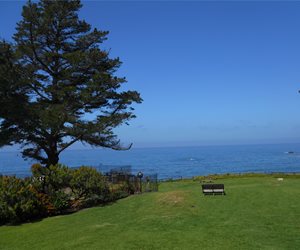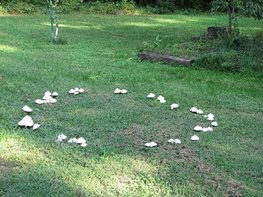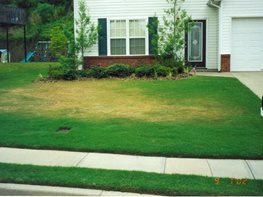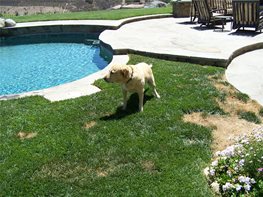Making Lawn Repairs
Establishing a systematic lawn repair program
Recreational activities can abuse your lawn. Overseeding on a regular basis helps to restore damaged areas.
Dogs will urinate, rabbits graze, cats will scratch, kids run and play. All of these activities can damage lawn areas. Prepare for and follow a systematic maintenance repair program to grow new plants to replace those that are abused and damaged. Professional football fields are overseeded on a weekly schedule during the playing season. Golf course superintendents routinely fence off areas being reseeded or that are recovering from excessive wear. Follow the examples of these pros and keep a supply of seed and topdressing handy for regular repairs. Seeding as part of a regular maintenance program, along with fertilization (six to eight times per year) and plug aeration, will help to ensure a vigorous lawn.
The tearing nature of foot traffic from dogs requires routine seeding and topdressing combined with placing obstacles in the pathway to allow time for turf to heal. Use benches, patio furniture, or temporary fencing to redirect your pet's traffic pattern.
Identifying and Fixing Brown Spots
Brown spots in the lawn can be caused by a variety of factors such as insect damage, lawn fungus, poor sprinkler coverage, or dog urine. Use this checklist to quickly identify the culprit before blaming your best friend.
Insect damage:
This usually presents itself as a spreading brown patch where the grass in the middle pulls up easily. The cause is typically root-chewing insects, like grubs and earwigs. Apply a pesticide to control these insects, and keep your pets away from the area at least until it is completely dry. It can be dangerous to overapply a pesticide, so always follow the directions on the label. Repeat treatments may be required.
Lawn fungus:
This often appears as "fairy rings," or 2- to 4-foot-diameter circular areas where grass can still be green in the center of the circle, but is surrounded by yellowing turf blades in circular patterns on the perimeter. The yellowing appears on the turf blade throughout and not just the tip. When you tear out a clump of grass, it may smell like mildew. If you suspect you have a lawn fungus, visit your local nursery for the recommended fungicide to treat the problem. Check your sprinkler coverage too; often fungus problems are brought on by drought-stressed conditions.
Drought-stress:
Lawns suffering from poor irrigation wilt from the top down. The tips of the blades will show signs of shrinkage or wilt before turning brown. An easy test for uniform sprinkler coverage of your lawn is to place coffee mugs in both the brown and green areas. Run your sprinkler system for about 15 minutes or so and check to see if the amount of water is the same in all the cups. This simple test will help you identify any sprinkler adjustments that may be necessary.
Dog urine:
Urine spots are usually brown in the center and surrounded by taller, lush green turf. Dog urine contains urea, a form of ammonia, and is very high in nitrogen. While small amounts of urea are good (it is a component in most lawn fertilizers), a concentrated dose of this natural ingredient burns the spot in the center where it gets too much fertilizer, but turns the grass greener all around the area. You would get a similar effect if you poured a cup of fertilizer in just one spot. You can repair these burn spots in three easy steps:
- Leach out the salts (urea) by flooding the area with water. If you have clay soil and the water just sits on top, try adding a couple of drops of mild dishwashing liquid to a bucket of water and pour it slowly over the spot. The little bit of added soap acts as a wetting agent and will break the surface tension of water and help it soak deep into the soil.
- Remove any dead turf and scarify (rough up) the soil to expose raw earth. Apply a handful of seed and work it into the top 1/4 inch of soil.
- Topdress the seed bed with mulch or loose, rich soil. Most turf seeds take 7 to 10 days to germinate during the growing season and need to be kept moist during this period. If you are seeding during a cooler time of year, use a little manure in your topdressing to add warmth and speed germination.

 Backyards
Backyards
 Front Yards
Front Yards






